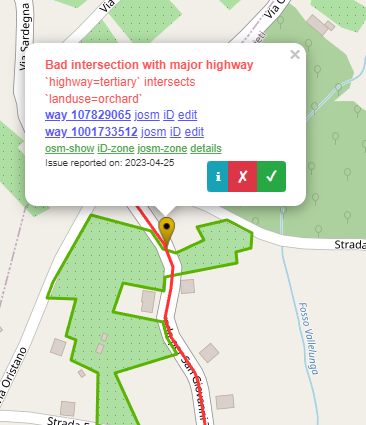Can one of the above commenting gentiles provide me a OSM wiki link, preferably the one in Oxford English, with this ‘don’t you dare’ prescriptive text?
TYSM
As for the warnings. Perusing the Italian landscape there’s tens of thousand if not hundreds of thousands of these issues yellow pinned. Maybe it’s just once per street like there’s only 1 warning for multiple buildings on agricultural land plot.
So far,
a) only tertiary roads and up get fingerpointed with the issue, residential not, unclassified anything below that not (yet).
b) landcover over tunnels (cant see why, there must be some peculiarity)
c) landcover below bridges (cant see why, there must be some peculiarity)
d) river’s, and maybe streams, but the 2 years or so I’ve been splitting landcover left/right bank to allow later inserting of the riverbed cover, shingles zones, wetland, flood zones etc.
Many mappers through yesterday continue to map LU and using roads to trace the outlines.
Found massive farmland acreages through which connecting/through roads pass that are flagged.
NOT seen multipolygons that go across, but maybe have not looked close enough. It’s similar to buildings on simple polygons agri lands being flagged but not when the agri land is an MP (could have been fixed but not seen any warning pins appear for that in my zone.)
Disturbing is I’m living in a hill/mountain area where few roads are straight. My favourite cycle way, a tertiary/secondary is 12km up, constantly twisting and turning through forest (though to me it’s wood). A mapping nightmare to split them tracing along the road edges, and not for the renderer, creating ugly whitespace on the maps.
For power line there’s the cutline feature which nicely maps a grassy beam where the powerlines/pipelines/fire breaks etc go without having to resort to area splitting.
Anyway, I’ve inserted a matchstick to hold the ignore button down for this one. I’ll consider applying the method on present and future map additions.


